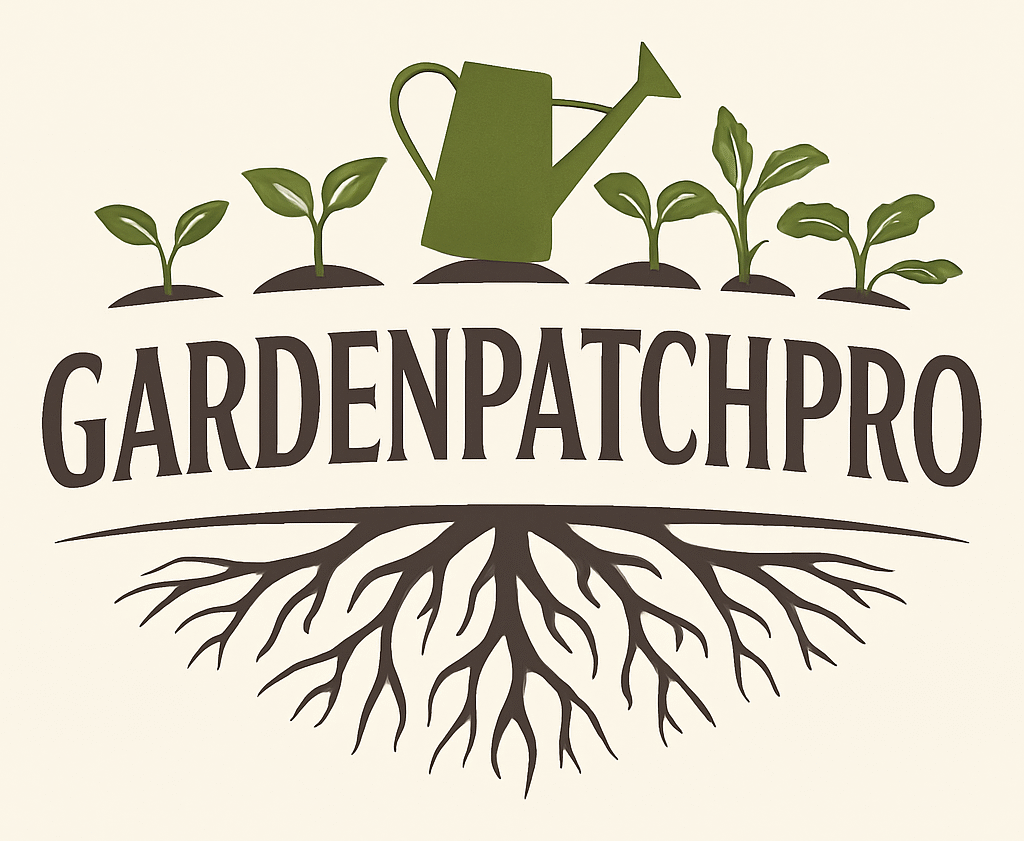16 Food Forest Ideas for Sustainable and Productive Gardens
A food forest is a garden that mimics a natural forest but focuses on growing edible plants. It uses layers of trees, shrubs, herbs, and ground covers to create a self-sustaining ecosystem. This approach can help people produce food in a way that is both productive and environmentally friendly.
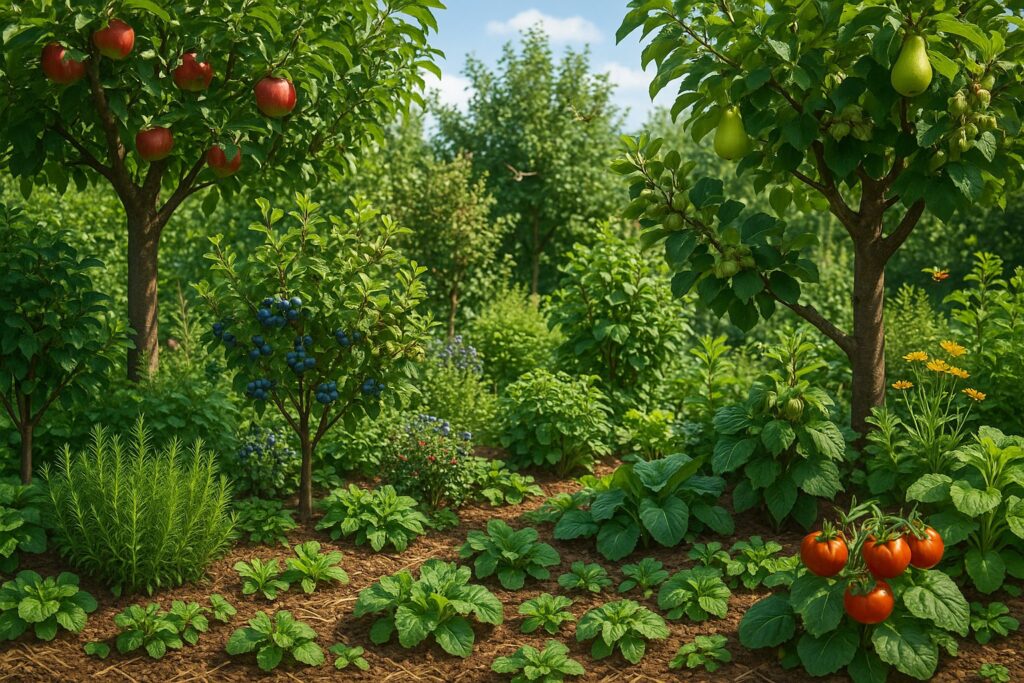
The main goal of a food forest is to provide a long-term source of food with less work and more natural support for the plants. Food forests can be designed for different spaces, from large backyards to small urban areas, offering a variety of options for growing fresh fruits, vegetables, and herbs. Understanding these ideas can help anyone start or improve their own food forest.
1) Start with a layered design including canopy, understory, shrubs, herbs, groundcovers, vines, and root crops

A layered design is key for building a balanced food forest. It mimics natural forests by arranging plants in vertical layers. This helps make the most of space and sunlight.
The top canopy layer includes tall trees like fruit and nut trees. These provide shade and create a microclimate that supports the layers below.
Underneath, the understory trees grow smaller but still produce food or add value. Shrubs come next, offering fruits or nuts while filling gaps in the garden.
Herbs and groundcovers form the lower layers. They protect soil, reduce weeds, and support pollinators. Vines can climb trees or structures, adding more yield without using extra ground space.
Root crops grow underground, making use of soil layers while other plants grow above. Together, these seven layers create a productive, sustainable system.
Starting small with just one canopy tree and a few more plants in other layers still brings many benefits. They work together to create a healthy, layered ecosystem. This design is a foundation for any food forest. For more details, see this guide on the seven layers of a food forest.
2) Incorporate nitrogen-fixing plants like black locust and clover to improve soil fertility
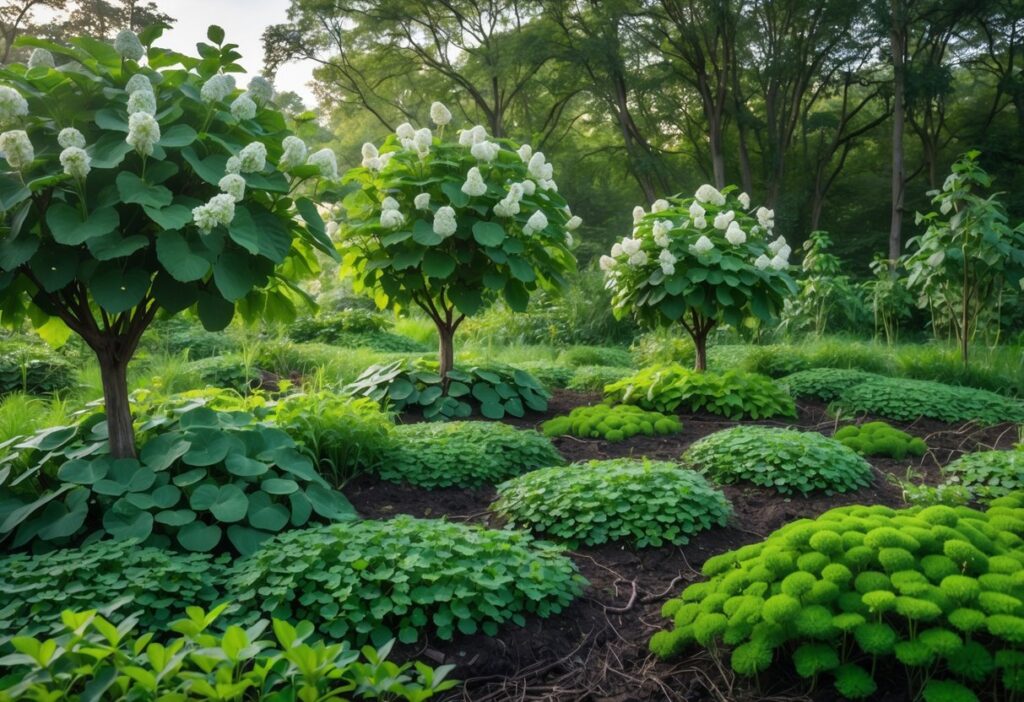
Nitrogen-fixing plants help add nitrogen to the soil naturally. This improves soil fertility and supports the growth of other plants in the food forest.
Black locust is a fast-growing tree that fixes nitrogen through its roots. It can be regularly pruned to keep it healthy and maintain nutrient cycling in the soil.
Clover is a common ground cover that fixes nitrogen while protecting the soil. It helps prevent erosion and can suppress weeds by covering bare ground.
Using these plants reduces the need for synthetic fertilizers. They create a healthier, more balanced ecosystem in the garden or farm.
Including a mix of nitrogen-fixing trees and ground covers increases the nutrient benefits. This combination supports diverse plant growth and long-term soil health.
More details on black locust and other nitrogen-fixing plants can be found at Native North American Trees Known for Replacing Nitrogen in the Soil.
3) Use guild planting by grouping supportive species such as comfrey with fruit trees
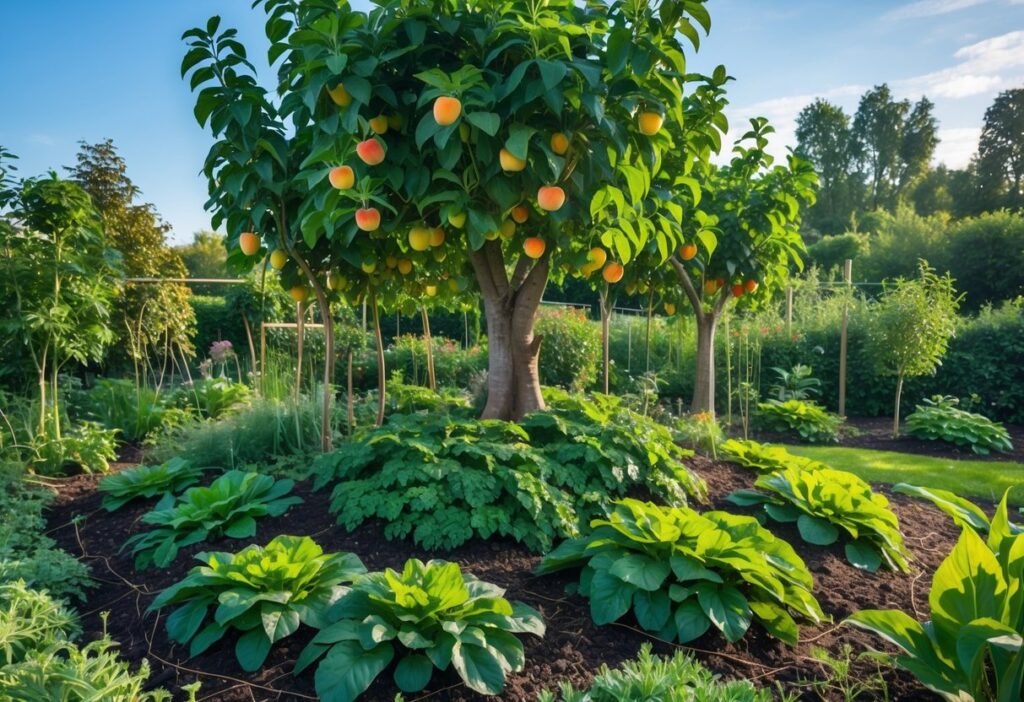
Guild planting means grouping plants that help each other grow. In a food forest, this often includes fruit trees surrounded by supportive plants like comfrey. Comfrey gathers nutrients from deep in the soil and shares them when its leaves break down.
Comfrey also helps keep the soil moist and prevents weeds from taking over. This reduces the need for watering and weeding. Other plants in the guild might attract pollinators or repel pests, creating a balanced mini-ecosystem.
By using guild planting, the fruit trees get better support from the surrounding plants. The result is healthier trees and improved fruit production. This approach mimics natural forests, where many plants grow together and support each other.
Learning how to build a fruit tree guild can help gardeners use space efficiently. Each plant in the guild has a job that benefits the whole group, making gardening easier and more productive.
4) Install swales or berms to capture and retain water on the site

Swales are shallow trenches dug along the contour lines of a slope. They help slow down rainwater, allowing it to soak into the soil instead of running off quickly. This reduces erosion and keeps the land moist.
Berms are raised mounds of earth placed just below the swales. They help hold the water in place and prevent it from washing away. Together, swales and berms create a simple and natural system to manage water on the site.
This method is especially useful on sloped land where water tends to run off fast. It supports plant growth by keeping roots hydrated. Installing swales and berms can lower the need for extra watering.
Planning swales requires marking contour lines on the landscape to guide where to dig and build earth mounds. The shapes and depth depend on the land’s slope and soil type.
Using swales and berms is a common practice in creating sustainable food forests. It improves water retention and soil health, making the environment more resilient during dry or wet periods. For more details, see techniques for building effective swales and berms.
5) Choose native fruit trees like apple, pear, and plum as primary layers
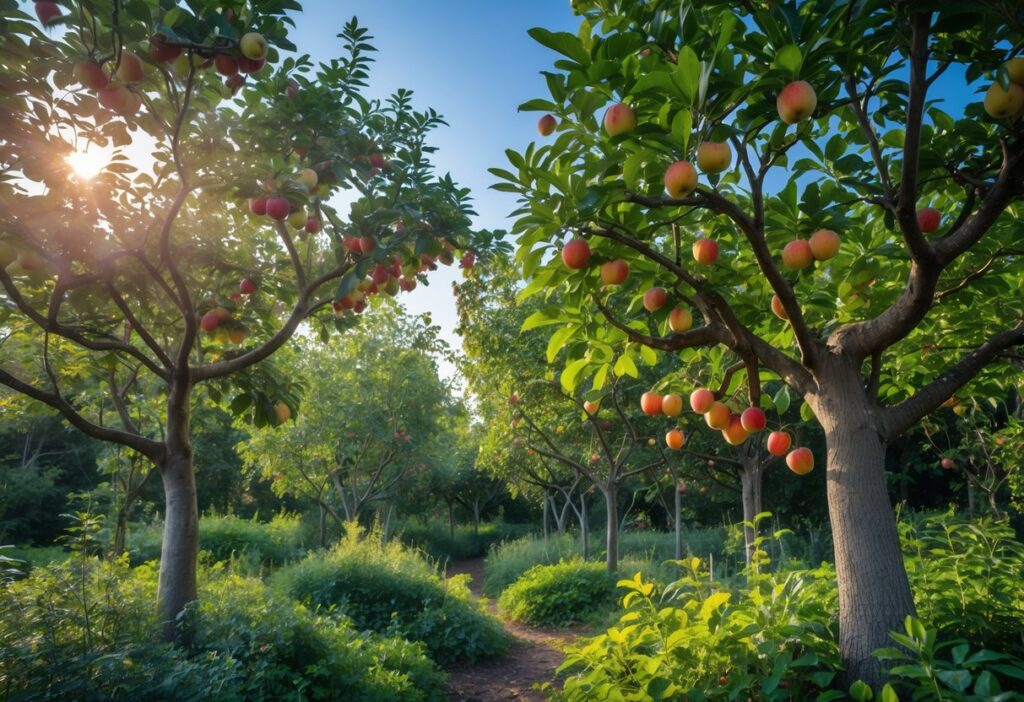
Native fruit trees such as apple, pear, and plum work well as primary layers in a food forest. These trees are adapted to the local climate and soil, which helps them grow stronger and produce fruit more reliably. They also support local wildlife by providing food and habitat.
Planting standard-sized apple, peach, plum, or pear trees gives a solid foundation to the food forest. These trees usually need space, about 15-20 feet apart, to allow sunlight to reach lower plants and to develop healthy crowns. This spacing supports better growth and fruit production.
Including these trees helps improve soil health too. They can be paired with nitrogen-fixing trees to enrich the soil naturally. Selecting varieties suited to a region increases the chance of success and reduces pest and disease problems. For more details on growing native fruit trees, see recommended practices on choosing the right trees for your area and climate.
Growing native fruit trees makes the food forest more sustainable and easier to maintain long term. For more info on native fruit trees options and how to care for them, check out this guide on native fruit trees for effortless, abundant yields.
6) Add berry bushes such as raspberries, blueberries, and currants for mid-layer yields

Berry bushes like raspberries, blueberries, and currants fit well into the middle layer of a food forest. They do not grow as tall as trees but provide a steady yield of fruit. This makes them a good choice to fill space between taller plants.
Raspberries and blackberries grow vigorously and produce fruit year after year. Blueberries need acidic soil but offer nutrient-rich berries and attractive foliage. Currants add variety with their tangy, sweet berries and often tolerate shade better than other bushes.
Planting groups of berry bushes creates natural barriers or living walls. They can also improve garden structure by adding color and texture throughout growing seasons. Berries grown this way provide easy harvest access while supplying fresh fruit.
Adding berry bushes boosts food forest diversity and increases overall yield without requiring much extra space. For tips on layout and care, see ideas for arranging fruit bushes like raspberries and blueberries.
7) Include perennial herbs like thyme, mint, and chives for pest control and culinary uses
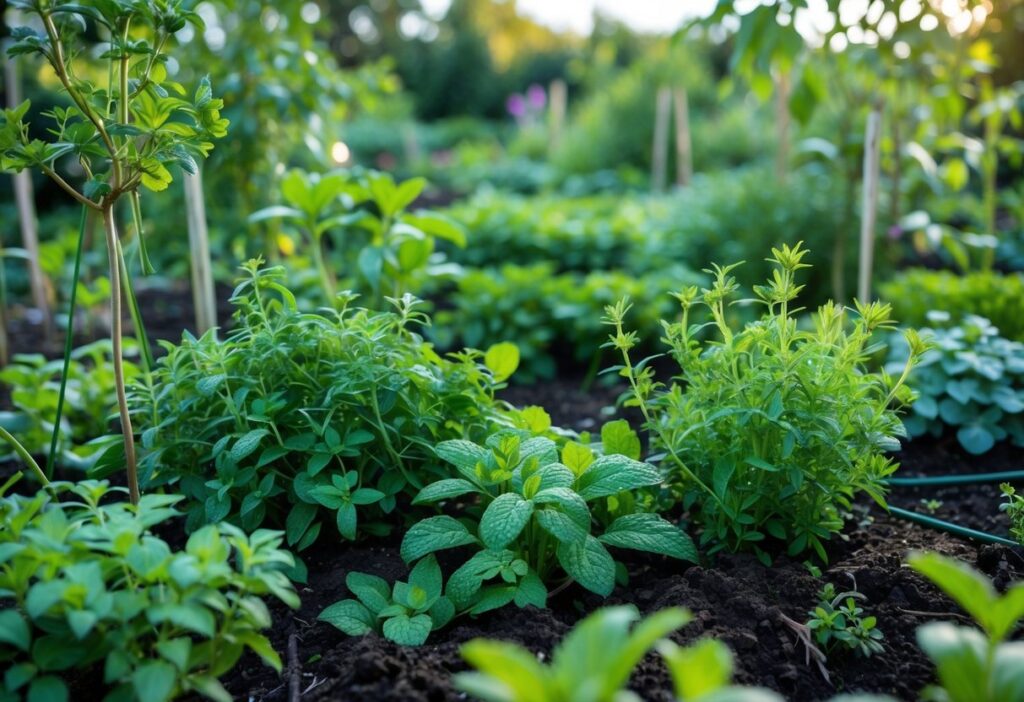
Perennial herbs such as thyme, mint, and chives serve dual purposes in a food forest. They provide fresh ingredients for cooking while also helping reduce pests naturally.
Thyme and mint have strong scents that can repel insects like aphids and mosquitoes. This makes them useful companions to fruit trees and vegetables. Chives attract beneficial insects that prey on harmful pests.
These herbs are easy to grow and return year after year, requiring little maintenance once established. They can be planted around the base of larger plants to create a natural barrier.
In addition to pest control, these herbs add flavor to meals and can be harvested throughout the growing season. They also provide ground cover, which helps reduce soil erosion and keep moisture in the soil.
Using perennial herbs supports a balanced ecosystem. By including thyme, mint, and chives, a food forest becomes healthier and more productive over time.
More details about growing perennial herbs can be found at Southern Living’s article on the best perennial herbs to grow in your garden.
8) Plant dynamic accumulators like comfrey or yarrow to mine deep nutrients
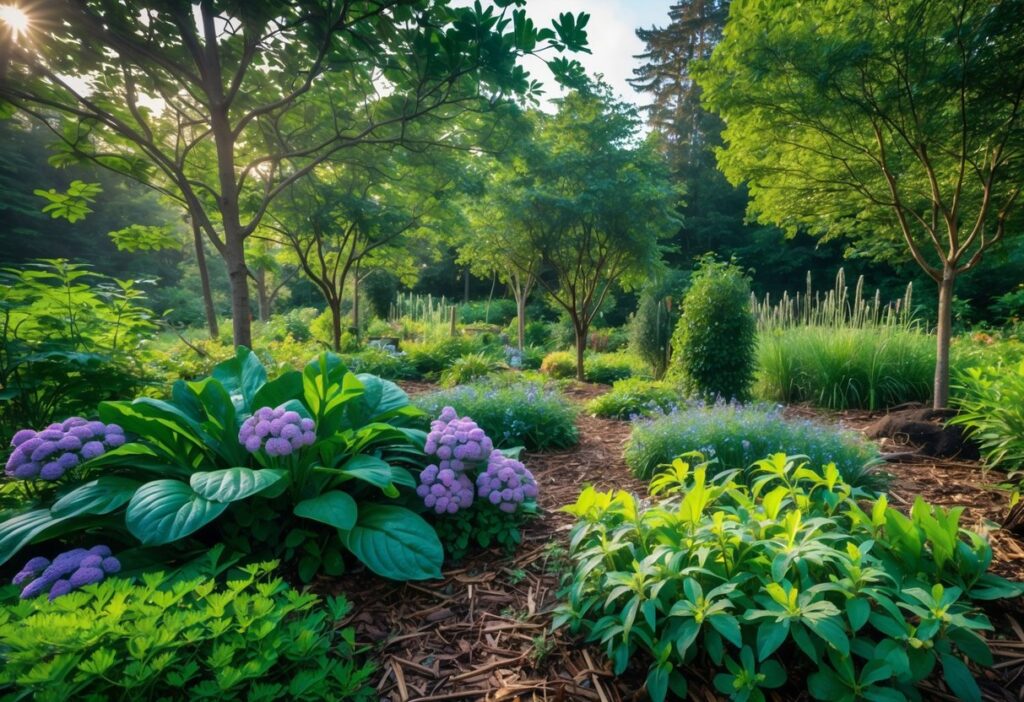
Dynamic accumulators are plants that pull nutrients from deep in the soil. They store important minerals like potassium, calcium, and nitrogen in their leaves. These minerals become available to other plants when the dynamic accumulators decompose or are used as mulch.
Comfrey and yarrow are common examples. Their deep roots break up compacted soil and help water reach lower layers. This improves soil health by cycling nutrients to the surface where other plants can use them.
Using dynamic accumulators reduces the need for synthetic fertilizers. Gardeners often harvest their leaves to add nutrients to compost or beds. This natural process supports a sustainable and healthy food forest.
Planting species like comfrey or yarrow builds fertility over time. They work quietly below ground, making the soil richer and better for growing fruits and vegetables. Learn more about how dynamic accumulators improve soil in a food forest.
9) Use vertical space with climbing vines such as grapes or kiwifruit
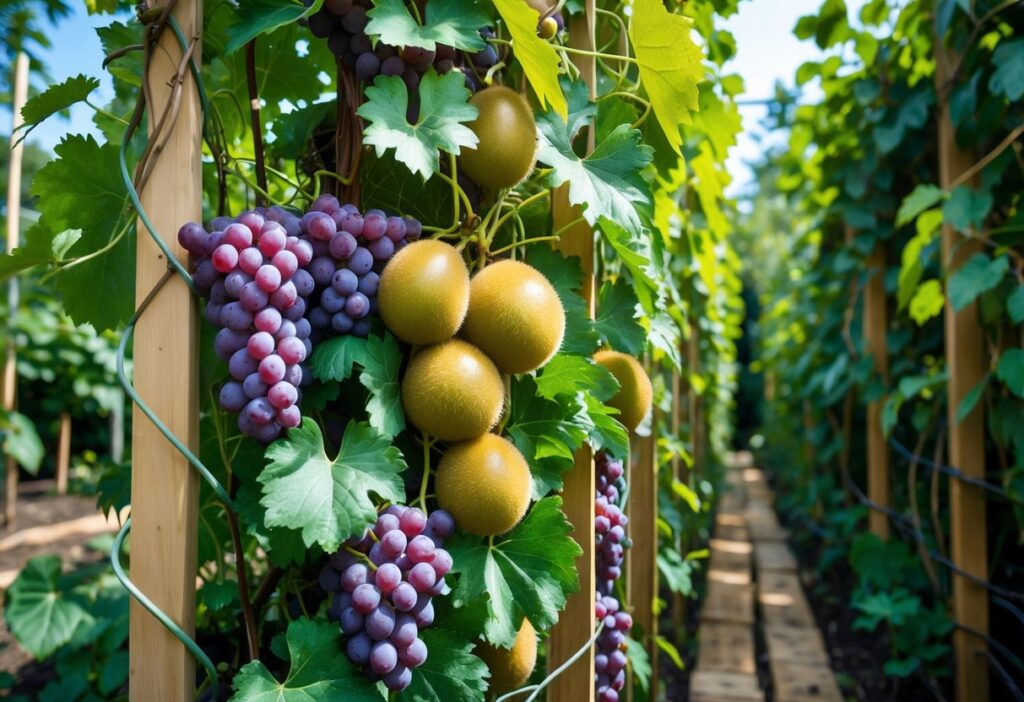
Climbing vines like grapes and kiwifruit are excellent for making the most of vertical space in a food forest. They grow upward on trellises or supports, which saves ground area for other plants.
Grapes are well-known for their ability to climb and produce clusters of fruit. They thrive in many climates and can provide shade as well as food.
Kiwifruit vines also climb easily and offer a unique fruit option. Some smaller varieties, like kiwi berries, have smooth edible skin and work well on vertical supports. These can fit into smaller garden spaces.
Using vertical space with these vines allows for more plants in limited areas. It also helps air circulation, reducing disease risks.
For gardeners looking to expand their yield without increasing garden size, climbing vines like grapes and kiwifruit are practical choices. More details about growing fruits on vertical supports can be found at fruits that grow on vines.
10) Integrate edible groundcovers like strawberries or creeping thyme to suppress weeds
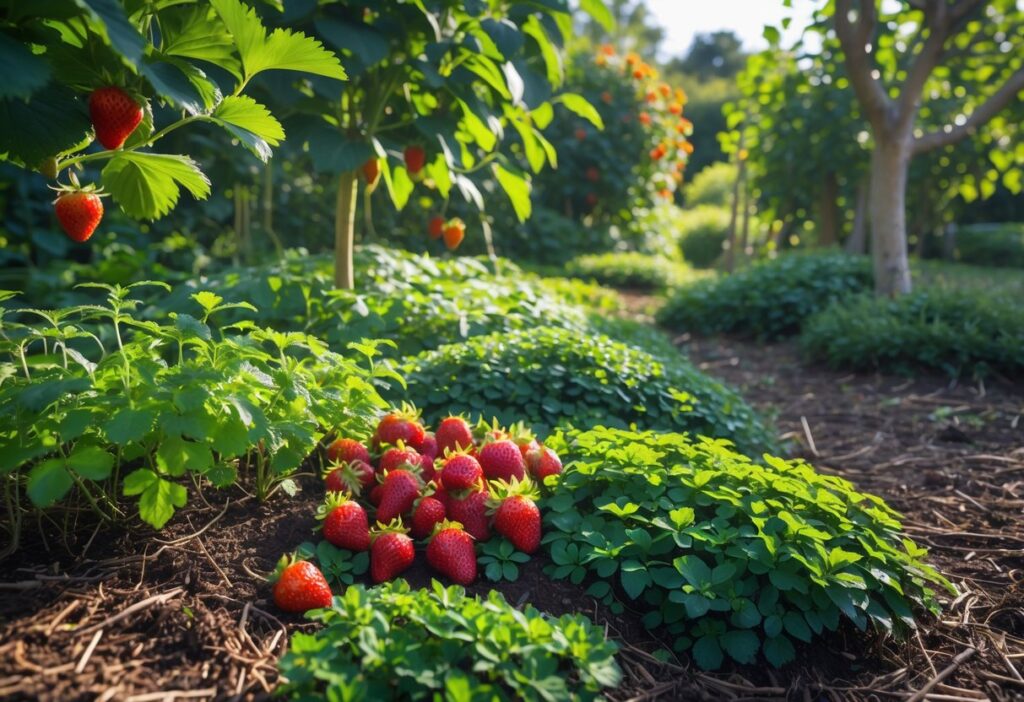
Edible groundcovers such as strawberries and creeping thyme serve a dual purpose in a food forest. They cover the soil densely, which helps block sunlight from reaching weed seeds. This natural weed suppression reduces the need for manual weeding or chemicals.
These plants also add value by producing food. Strawberries yield sweet berries, while creeping thyme offers flavorful leaves for cooking. Both require little care beyond occasional watering and light weeding.
Because they spread horizontally, these groundcovers fill empty spaces, making a food forest more resilient and productive. They improve soil health by reducing erosion and retaining moisture. This helps other plants in the area grow stronger.
Adding edible groundcovers creates a functional layer in a food forest system. They support biodiversity by attracting pollinators and beneficial insects. Including plants like strawberries and thyme is a practical way to boost both productivity and garden health.
More ideas on edible groundcovers can be found in this guide to best edible ground cover plants.
11) Create spiral herb gardens to maximize space and diversity
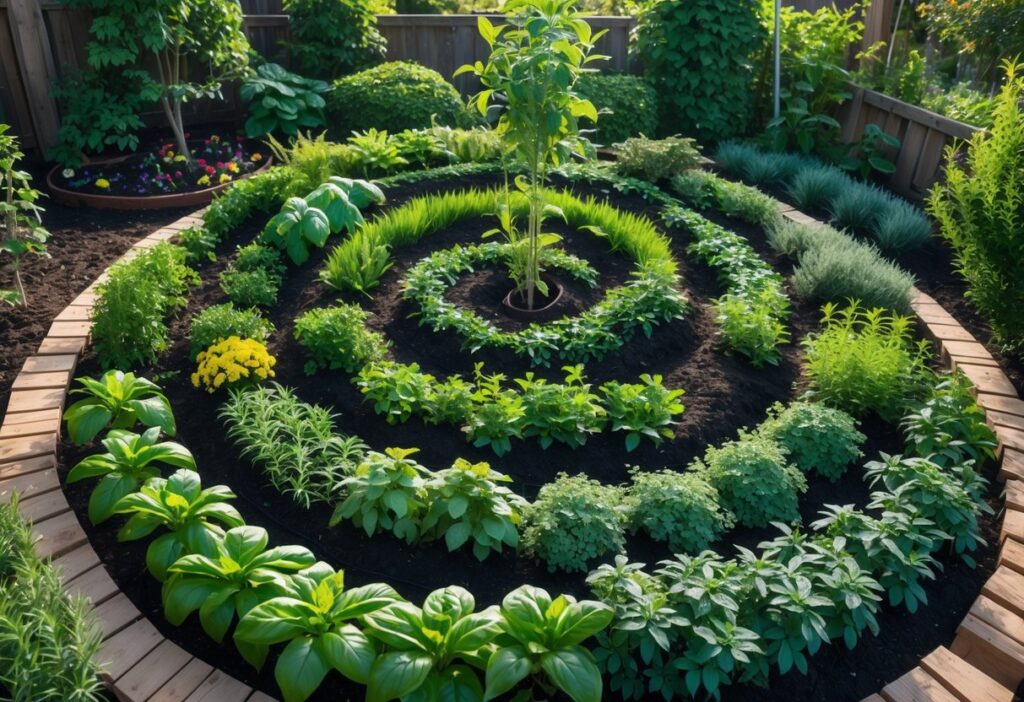
Spiral herb gardens use a vertical, winding design that fits many plants in a small area. The shape creates different microclimates, offering spots that are dry, moist, sunny, or shaded. This allows a variety of herbs to grow well together in one compact space.
The design mimics natural ecosystems and helps conserve water. Plants with similar needs can be grouped on the right parts of the spiral, improving their growth and health. It is a practical choice for small yards or patios.
Building a spiral herb garden often involves simple materials like stones, bricks, or wood. The raised structure improves drainage and soil conditions. Its layered layout makes harvesting easy, as herbs are within reach at different heights.
This approach fits well within food forests because it increases biodiversity. Gardeners can grow culinary and medicinal herbs in one spot, making efficient use of limited space. For a detailed guide and design ideas, see creating an herb spiral garden.
12) Add mushrooms like shiitake or oyster to decompose organic matter and provide food
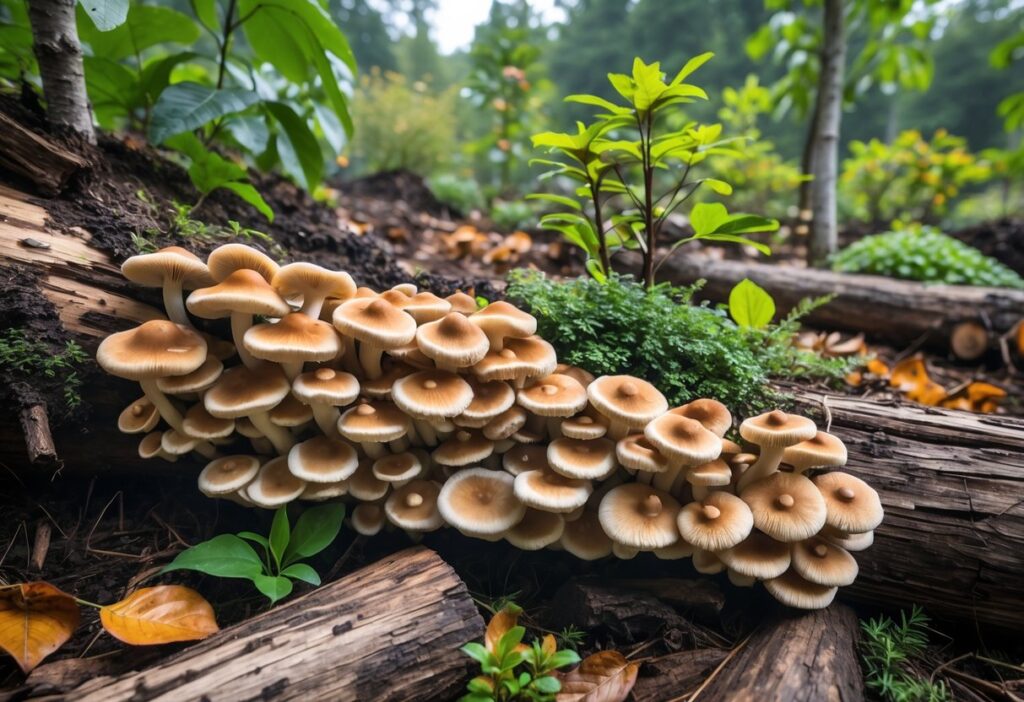
Mushrooms such as shiitake and oyster are valuable additions to a food forest. They grow on dead organic material, like wood and straw, helping to break it down. This process returns nutrients to the soil, improving its quality.
These mushrooms are also edible and nutritious. They offer protein, vitamins, and antioxidants, making them a healthy food source. Shiitake mushrooms prefer oak wood, while oyster mushrooms grow well on pasteurized straw or coffee grounds.
Growing mushrooms in a food forest supports sustainability. The mycelium, a thread-like network beneath mushrooms, breaks down tough matter like leaves and twigs. This helps recycle nutrients naturally, boosting plant growth in the area.
Adding these mushrooms can also provide an ongoing harvest. They grow fairly quickly, with oyster mushrooms producing in about two weeks. This makes them a good option for regular food production alongside forest plants.
For more details on farming shiitake and oyster mushrooms and growing them effectively, see farming exotic mushrooms like shiitake and oyster mushrooms.
13) Mulch heavily with wood chips or straw to conserve moisture and improve soil

Mulching with wood chips or straw creates a protective layer over the soil. This helps reduce water evaporation, keeping the soil moist for longer periods.
Over time, organic mulches like wood chips break down and add nutrients to the soil. This process improves soil structure and supports healthy plant roots.
Using mulch also helps prevent weeds by blocking sunlight. Fewer weeds mean less competition for water and nutrients in the food forest.
Choosing between wood chips and straw depends on availability and specific garden needs. Both materials are effective, but wood chips tend to last longer while straw breaks down faster.
Properly applied mulch should be spread in a thick layer, about 2 to 4 inches deep. This thickness balances moisture retention without causing excess moisture buildup that could harm roots.
For detailed advice on mulch types and their benefits, see this guide on best mulches for moisture retention.
14) Incorporate small livestock or poultry for nutrient cycling and pest control
Small livestock and poultry can play an important role in a food forest. Animals like chickens, ducks, or rabbits help recycle nutrients by breaking down plant waste and returning it to the soil as natural fertilizer. This helps improve soil health and boosts plant growth.
Poultry often eat pests such as insects, reducing the need for chemical pest control. They can also scratch the ground, helping to prepare soil for planting and control weeds.
Keeping small animals in a food forest creates a more balanced ecosystem. Their natural behaviors support nutrient cycling and pest management. Adding livestock to a food forest makes the system more sustainable and productive over time.
For more on how livestock supports nutrient cycling and pest control, see this article on integrating livestock into permaculture designs.
15) Plan for year-round harvest by mixing early, mid, and late season plants

A successful food forest includes plants that mature at different times. Early-season crops grow fast and can be harvested first. Mid-season plants take longer and fill the garden after early crops are done. Late-season crops mature last, extending the harvest into fall and even winter.
By planting a mix of varieties, a gardener can enjoy fresh food over many months. This staggered timing also helps avoid having too much produce all at once. Regularly sowing quick-growing plants throughout the season keeps the harvest steady.
Choosing crops suited for your local climate is important. Cool-season vegetables like broccoli and kale do well in spring or fall. Warm-season plants such as tomatoes and peppers grow best in summer heat. Planning around these growing conditions ensures continuous crops.
This strategy supports efficient garden space use. It maximizes the harvest without needing a bigger area. For detailed timing and crop ideas, see advice on planting schedules for year-round harvest.
16) Use rainwater harvesting systems to reduce irrigation needs
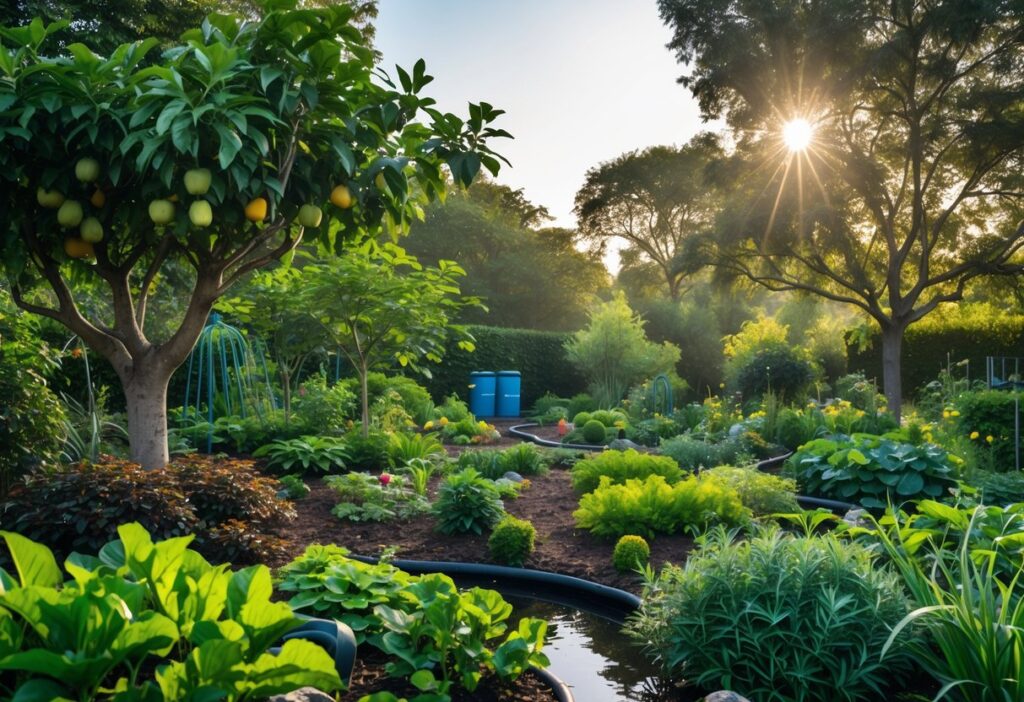
Rainwater harvesting systems collect rainwater from rooftops or surfaces. This water is stored in barrels, tanks, or cisterns for later use. Using collected rainwater helps cut down the need for tap or groundwater irrigation.
These systems reduce water bills and conserve local water resources. They also decrease runoff, which lowers erosion and pollution in nearby areas. Rainwater is often cleaner than groundwater, making it better for plants.
A basic system includes gutters to capture rain, downspouts to direct the flow, and storage containers. The stored water can be used during dry periods to keep a food forest healthy without depending on city water.
Installing rainwater harvesting systems provides a sustainable way to manage water. It supports drought resistance in gardens and landscapes. For practical tips, guides like those on rainwater harvesting for irrigation offer clear steps to start collecting rainwater effectively.
Design Principles for Food Forest Success
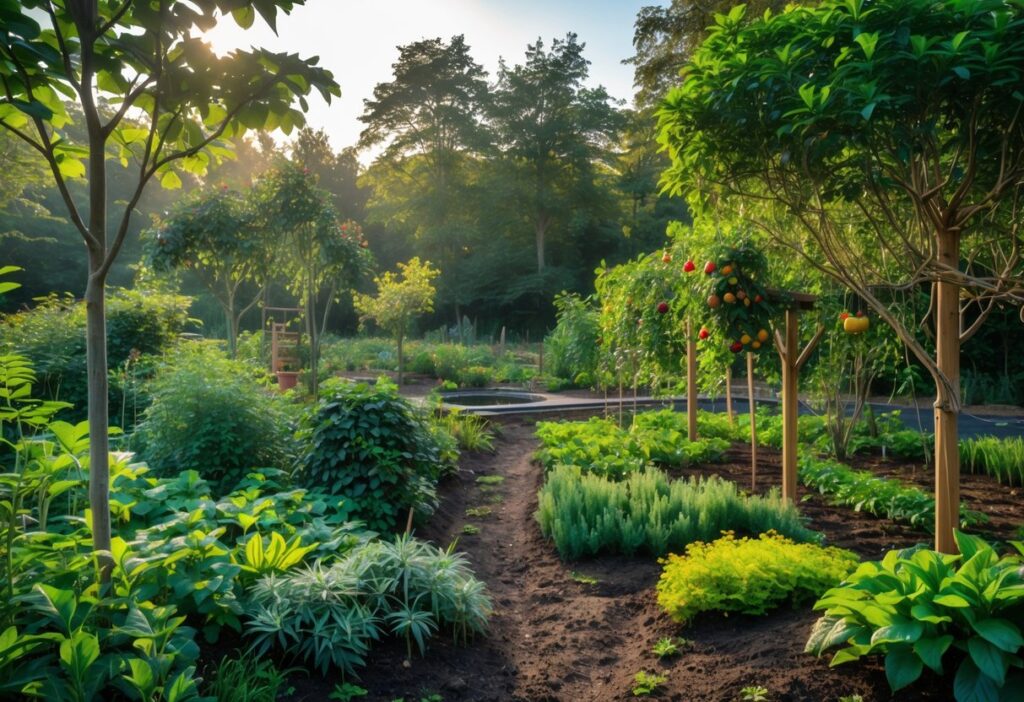
A food forest thrives by carefully planning its environment, plant interactions, and long-term health. Choosing the right location, arranging plants in productive layers, and creating strong plant communities are key to lasting growth and yield.
Site Assessment Strategies
Before planting, the site must be thoroughly analyzed. Key factors include sunlight exposure, soil type, drainage, and wind patterns. Understanding these helps determine which plants will thrive.
Testing soil pH and nutrients guides amendments. Water availability must be checked, as food forests benefit from well-distributed moisture. Mapping microclimates—areas with slightly different temperatures or humidity—can direct where sensitive or hardy plants are placed.
Assessing slope and elevation helps manage erosion and water flow. It’s important to avoid areas prone to flooding. This groundwork ensures plants can establish well and minimize maintenance later.
Layering for Productive Systems
Food forests use multiple plant layers to maximize space and resources. These layers mimic natural forests and include:
- Canopy trees: Tall fruit or nut trees like oak or walnut
- Understory trees: Smaller fruit trees beneath canopy, like plums or peaches
- Shrubs: Berries or nitrogen-fixing plants
- Herbs: Culinary or medicinal plants that help pests or soil
- Groundcovers: Low-growing plants that suppress weeds and hold moisture
- Roots: Edible tubers or soil enhancers
Each layer serves a role in food production, soil health, or pest control. Proper layering increases yields without extra space or water.
Building Resilient Plant Communities
Resilience comes from diversity and balance. Mixing plant species reduces pest outbreaks and improves soil quality. Including nitrogen fixers like clover or lupines boosts fertility naturally.
Plants that attract beneficial insects or provide habitat for wildlife help control pests without chemicals. A mix of perennials and annuals supports continuous growth and harvests.
Spacing plants so they don’t compete for nutrients or water is important. Companion planting principles guide good combinations. Resilient communities recover faster from stressors like drought or disease. This leads to food forests that sustain themselves over many seasons.
For more details on these design methods, the guide on designing a food forest offers valuable insight.
Long-Term Maintenance and Sustainability
Maintaining a food forest requires conscious care to keep soils healthy and plants thriving over time. Effective strategies support natural cycles and reduce external inputs. Managing pests without chemicals protects beneficial insects and keeps the ecosystem balanced.
Soil Regeneration Techniques
Soil health is the foundation of a food forest. Regularly adding organic matter, such as compost or mulch, boosts nutrients and improves soil structure. Using cover crops or nitrogen-fixing plants like clover or peas adds vital nitrogen, which helps other plants grow.
Rotating plant species in certain areas prevents nutrient depletion. Avoiding soil compaction by walking on designated paths protects root systems. Mulching with wood chips or leaves controls weeds, retains moisture, and slowly releases nutrients.
Key soil actions for long-term success include:
- Applying 2-4 inches of organic mulch annually
- Planting cover crops between main crops
- Avoiding tilling to preserve soil life
These practices build a living soil that feeds the forest naturally.
Integrated Pest Management in Food Forests
Food forests rely on diversity to control pests naturally. Introducing a mix of flowering plants attracts pollinators and predator insects like ladybugs and lacewings that feast on common pests. Using barriers such as row covers or netting protects young plants from insects and birds without chemicals.
Regular monitoring helps catch problems early. Removing infested leaves manually reduces pest populations. Companion planting—growing pest-repelling plants like garlic, marigold, or nasturtium near vulnerable crops—adds another layer of defense.
Key integrated pest management steps include:
- Encouraging beneficial insects with nectar plants
- Physical pest barriers
- Manual removal of pests
- Companion planting for natural repellence
This approach avoids harmful pesticides and strengthens the forest’s resilience.
For more details and tips, see Creating a Food Forest in Your Backyard.
Frequently Asked Questions
A food forest depends on careful planning of layers, plant choices, and water management. Understanding soil improvement, plant groupings, and climate adaptability helps create a resilient and productive system.
What are the essential components of a small food forest design?
A small food forest includes multiple layers such as canopy trees, understory trees, shrubs, herbs, groundcovers, vines, and root crops. It maximizes space by using vertical and horizontal planting structures.
Incorporating nitrogen-fixing plants like clover and black locust improves soil health. Water retention methods like swales or berms help maintain moisture levels even in limited space.
How can permaculture principles be applied to creating a food forest?
Permaculture focuses on creating self-sustaining ecosystems by mimicking natural forests. It uses techniques like guild planting, where supportive plants grow together to enhance growth and pest control.
Designing for water capture and minimal maintenance aligns with permaculture. Choosing perennial plants reduces the need for frequent replanting.
What are some examples of successful food forests in diverse climates?
Food forests with native fruit trees such as apple, pear, and plum thrive in temperate zones. In warmer climates, species like figs and pawpaw work well.
Site design adapts by selecting drought-tolerant plants or moisture-loving species depending on rainfall. Understanding local conditions guides species choice.
What is the 70/30 rule and how does it relate to food forest gardening?
The 70/30 rule means about 70% of the area should have perennial plants and 30% annuals or other fast-growing plants. This balance supports long-term sustainability.
Mostly planting perennials ensures lower maintenance and steady food supply. Annuals fill gaps and provide quick yields while trees and shrubs establish.
In practical terms, how would you structure the different layers of a food forest?
Start with tall canopy trees like apple or pear as the top layer. Beneath, plant smaller understory trees such as hazelnut.
Add shrubs like currants or blueberries below those. Herbaceous plants and groundcovers like comfrey or clover fill the lower layers. Vines can climb trees or trellises, while root crops grow underground.
What are some perennial plants commonly used in establishing a food forest?
Common trees include apples, pears, plums, and walnuts. Shrubs often include blueberries, raspberries, and elderberries.
Herbs and groundcovers like comfrey, mint, and clover improve soil and provide yields. Nitrogen-fixing plants such as black locust support nutrient cycling within the forest.
For more detailed approaches, see 7 food forest design ideas for small properties that maximize harvests.
